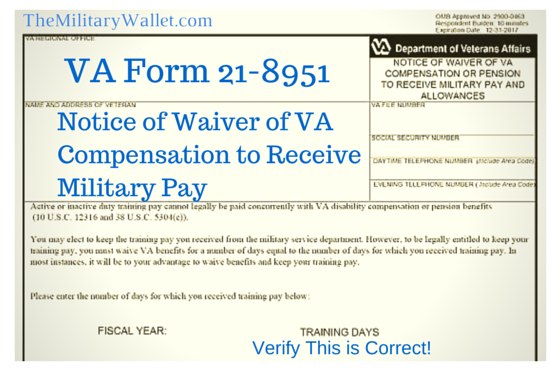Members of the Guard or Reserves are eligible to serve if they have a VA service-connected disability, provided they are physically cleared. However, there is one big caveat: they cannot receive VA compensation on the same day they receive military pay. To serve again, you must waive either your VA pay or your military compensation.
Table of Contents
How Military Pay Works with VA Disability Compensation
The law states you cannot receive both forms of payment for the same day or work. However, both payments are actually made at the same time. You will receive your VA disability payment around the first of the month, and you will receive your drill pay at the normal payment schedule.
At the beginning of the year (usually around February), you should receive VA Form 21-8951, Notice of Waiver of VA Compensation or Pension to Receive Military Pay and Allowances (pdf). You will use this form to elect which pay you want to waive—your VA pay, or your military pay.
We will cover the information on this form, what it means, and how to fill it out.
Notice: Annual Waiver Required. This form is now an annual requirement. The VA previously offered a one-time waiver of disability benefits that was to remain in effect until your Guard or Reserve status changed, or you withdrew the waiver. That form is no longer valid.
Information Found on Form 21-8951
Your form 21-8951 will show the fiscal year and the number of training days you performed during the year. A normal drill year would be approximately 63 military training days: 48 drill days (12 months times 4 drill periods per month), and 15 active training days.
Your form 21-8951 will also include information on the following:
- Instructions on how to complete the form,
- your VA File number & Social Security Number,
- a check box to verify the information is correct, or
- a check box to mark that the information is incorrect and a space to mark the correct number of days served.
- a section to elect which pay to waive (note: waiving military pay and allowances will most often result in LESS money for you; this is marked clearly on the form),
- a section to verify the information and sign it,
- a section for your unit Commander to sign the form.
Filling out Form 21-8951
There are only three sections where you can take any action. If the information on your form is correct, check the first box in the first section. Next, determine which pay to waive (see below section), then sign and date.
According to the VA, M21-1MRIII_v_4_secC (Word Doc):
- The Veteran must always sign VA Form 21-8951.
- The Veteran’s unit commander must sign VA Form 21-8951 only if the Veteran reports fewer training days than the Hines ITC printed on the form.
If your information is correct, then you do not need to have your unit Commander sign it. However, the veteran is always required to sign and return the form.
Note on VA Form 21-8951-2. This form is essentially a blank version of Form 21-8951. It will not have the number of training days listed, and you will need to self-report the number of days for which you received pay. The VA always requires both the Veteran and the Veteran’s unit commander to sign VA Form 21-8951-2.
Should you get your Commander to sign the form if there are no errors on your form? I’m not going to tell you to do it or not to do it. But think of it this way: most Commanders are very busy. Do you want to interrupt their schedule to sign something unnecessary? And do you want to call attention to yourself for having a service-connected disability? I’ll let you answer those questions.
What if there are Errors on Your Form 21-8951?
If there are errors on your Form 21-8951, you need to get the correct information from your unit personnel or finance department. Then you will need to write in the corrected information in the section on the back.
Important: If there are errors on your form, you will need to get your Unit Commander or Designee to verify the correct number of training days and sign your form.
How to Decide Which Pay to Waive
The calculation is simple:
- Review your base military pay for a full month as if you were on active duty.
- Review your monthly VA disability compensation rate.
- Waive whichever pay is lower.
Important: You must look at the full monthly rate for your pay grade and time in service, not your drill pay!
Why do you compare the full monthly rate for military base pay and VA disability compensation?
Because you must compare apples to apples. The long-hand method is to determine exactly how much you earned from the VA for the period you earned military compensation, then compare that to how much you earned from the military. But that takes a lot of work.
The government gives us a shortcut: Each day counts as 1/30th of a month’s rate. So if your VA disability compensation were $300 a month, each day of VA disability compensation is worth $10 per day. And if you earn $3,000 in military base pay, each day is worth $100.
Because both systems prorate compensation the same way, you don’t need to determine how much money you earned from the VA or the military. Whichever base pay is higher is the one you want to keep. And you want to waive the lower monthly payment rate.
It should be quick and easy to determine which payment is better to waive. In most cases, you will be better off keeping your military pay and waiving your VA pay for the period involved.
The only time your VA pay will be higher than your military pay is if you have a very high VA disability rating and are a low or mid-ranking military member. But you should always run the numbers to verify.
What Happens After You Waive Your Pay?
The government will simply withhold future payments. So if you have 63 days of military pay and elect to waive your VA compensation, you would have roughly the next two months of disability payments withheld. You can run the numbers to determine exactly how much will be withheld.
Remember, each day counts as 1/30th of a month’s rate. So if your VA disability compensation were $300 a month, each day of VA disability compensation is worth $10. If you have 63 days of military pay and waive your VA compensation, you would have $630 withheld, $300 in each of the first two months, then $30 from the next month. After that, your full compensation payments will resume.
Final Notes
Form 21-8951 includes the following statement: “If we do not receive a waiver from you, we will assume that you wish to waive VA compensation or pension for the number of days printed on the front of the form. However, we will not adjust your award until we have advised you of the specific changes we propose to make.”
That said, everything I have read states completing this form is a requirement if you receive both VA disability compensation and payment from the military. Training days can include all forms of military service while in the Guard or Reserves, including Inactive Duty Training (IDT), Active Training (AT), Active Duty Special Work (ADSW), Readiness Management Assemblies (RMA), activation for training, mobilization, etc.
However, you should also note that if you are called to active duty for an extended period, you should contact the VA to suspend your VA compensation payments until you return to inactive status.




Comments:
About the comments on this site:
These responses are not provided or commissioned by the bank advertiser. Responses have not been reviewed, approved or otherwise endorsed by the bank advertiser. It is not the bank advertiser’s responsibility to ensure all posts and/or questions are answered.
Shayne Owens says
Good Afternoon,
Are reservists required to fill out a VA Form 21-8951 if we are only drilling for points (no pay)?
Thank you.
-Shayne
Ryan Guina says
Shayne, VA Form 21-8951 only lists days in which you receive military pay. So I don’t see why you would need to fill out the form if you are only drilling for points.
Marie Dautenhahn Robinett says
HI, I found your site after receiving a notice from the VA that I owed them money for an entire year of drills performed. My disability started at the end of May 2019 and I retired in Nov 2019. I appealed, and thought it was fixed. Now I have a letter I owe them over $7,800 because I didn’t waive my disability pay while I drilled. I have binders with all my paperwork and I don’t have any record of ever receiving the VA Form 21-8951 from any source, (Guard, VA, my PEBLO- nothing). It appears they are trying to collect for 64 days in 2019 and 9 days in 2020. Whose job was it to give me the form in the first place? I don’t see it in any checklist and it definitely wasn’t part of my VA counseling. And why are they calculating for an entire year in 2019, and more days than I actually drilled in 2020???
Ryan Guina says
Hello Marie,
Thank you for your question. The VA sends veterans a copy of Form 21-8951 once a year. However, it doesn’t always come at a set schedule. They try to send it near the beginning of the year, however, I know people who have received it pretty much any time throughout the year.
2020 was also a weird year for VA disability compensation and drilling members of the Guard or Reserves. As you mentioned, drilling while receiving VA disability compensation creates a debt to the VA. However, due to the pandemic, the VA paused collections of these debts for many veterans (this would include the debts incurred for 2019 military service). I don’t know if your debt was paused or not. Only the VA can tell you that.
As far as your situation goes, I recommend printing a copy of your Points Summary Statement, drill orders, or any official documentation you have that shows the specific dates in which you served in a military capacity during the 2019 calendar year. You will want to be able to show the date your disability award started and cross-reference your military service to show the total overlap of the days served. Keep in mind that you want to show the effective date of your VA disability award – sometimes they are backdated. If your award was backdated to May, then use that date. If the decision was made in May, but backdated to an earlier date, use the earlier date. It will also be helpful if you have a copy of the appeal letter and documentation you previously sent.
With that information in hand, you should visit a VA customer service representative to have them help you with this situation. Hopefully, this can be done in person with someone who has the knowledge and authority to update the system for you. If not, see if they can assist you with filling out another letter of appeal.
You may also wish to seek assistance from a Veterans Service Organization such as the DAV, AMVETS, American Legion, VFW, etc. They have trained benefits counselors who may be able to assist you.
I hope this points you in the right direction and I wish you the best!
Ruth says
which should I elect to waive if I have 47 training days and I receive 1000 a month of VA compensation. my monthly military pay is about 400.
Ryan Guina says
Hello Ruth,
The easiest way to determine which pay to waive is to look at the full monthly base pay for each form of compensation and waive the lower of the two.
For example, say you earn $1,000 a month from the VA and the base military pay for your rank and time in service is $3,000 per month. In this case, you would want to waive your VA disability compensation.
The reason this works is that these payments are prorated on a monthly basis. Your $400 drill pay is based on serving 4 days out of 30. If you only had 4 days of VA disability compensation, it would be $133.33.
If you look at all 47 days, you would get VA compensation ($1566.67) and military pay ($4,700.00), again, assuming a base military pay of $3,000.
In this case, waive your VA disability compensation.
Best wishes!
Xavier says
How does submission work? What is the prime submission date to account for waiving Comp pay on your drill dates, Should I submit asap since we are already within FY21 and with this time frame being already October 23 are there impacts??